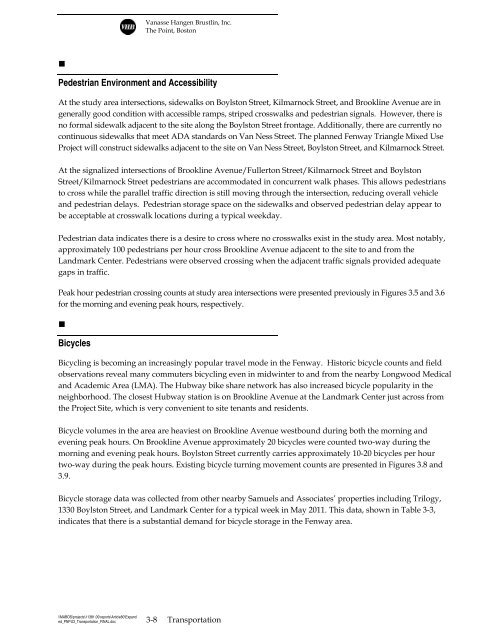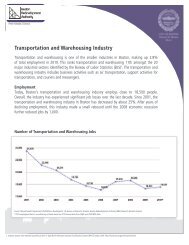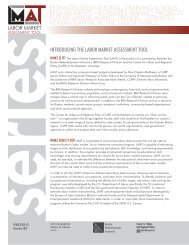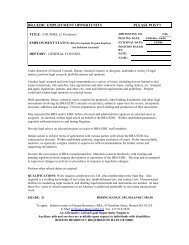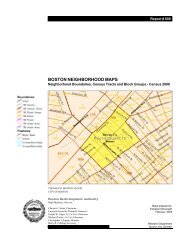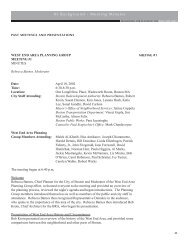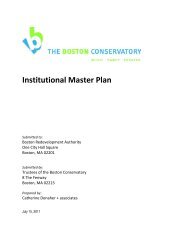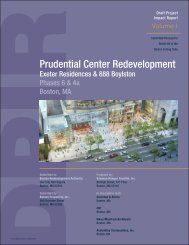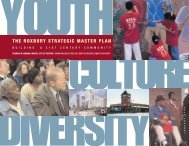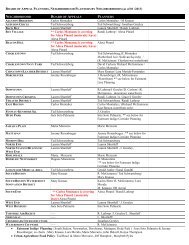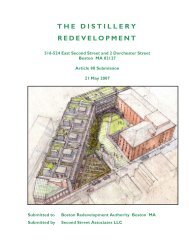point cover jan 13 - Boston Redevelopment Authority
point cover jan 13 - Boston Redevelopment Authority
point cover jan 13 - Boston Redevelopment Authority
Create successful ePaper yourself
Turn your PDF publications into a flip-book with our unique Google optimized e-Paper software.
Vanasse Hangen Brustlin, Inc.<br />
The Point, <strong>Boston</strong><br />
Pedestrian Environment and Accessibility<br />
At the study area intersections, sidewalks on Boylston Street, Kilmarnock Street, and Brookline Avenue are in<br />
generally good condition with accessible ramps, striped crosswalks and pedestrian signals. However, there is<br />
no formal sidewalk adjacent to the site along the Boylston Street frontage. Additionally, there are currently no<br />
continuous sidewalks that meet ADA standards on Van Ness Street. The planned Fenway Triangle Mixed Use<br />
Project will construct sidewalks adjacent to the site on Van Ness Street, Boylston Street, and Kilmarnock Street.<br />
At the signalized intersections of Brookline Avenue/Fullerton Street/Kilmarnock Street and Boylston<br />
Street/Kilmarnock Street pedestrians are accommodated in concurrent walk phases. This allows pedestrians<br />
to cross while the parallel traffic direction is still moving through the intersection, reducing overall vehicle<br />
and pedestrian delays. Pedestrian storage space on the sidewalks and observed pedestrian delay appear to<br />
be acceptable at crosswalk locations during a typical weekday.<br />
Pedestrian data indicates there is a desire to cross where no crosswalks exist in the study area. Most notably,<br />
approximately 100 pedestrians per hour cross Brookline Avenue adjacent to the site to and from the<br />
Landmark Center. Pedestrians were observed crossing when the adjacent traffic signals provided adequate<br />
gaps in traffic.<br />
Peak hour pedestrian crossing counts at study area intersections were presented previously in Figures 3.5 and 3.6<br />
for the morning and evening peak hours, respectively.<br />
<br />
Bicycles<br />
Bicycling is becoming an increasingly popular travel mode in the Fenway. Historic bicycle counts and field<br />
observations reveal many commuters bicycling even in midwinter to and from the nearby Longwood Medical<br />
and Academic Area (LMA). The Hubway bike share network has also increased bicycle popularity in the<br />
neighborhood. The closest Hubway station is on Brookline Avenue at the Landmark Center just across from<br />
the Project Site, which is very convenient to site tenants and residents.<br />
Bicycle volumes in the area are heaviest on Brookline Avenue westbound during both the morning and<br />
evening peak hours. On Brookline Avenue approximately 20 bicycles were counted two-way during the<br />
morning and evening peak hours. Boylston Street currently carries approximately 10-20 bicycles per hour<br />
two-way during the peak hours. Existing bicycle turning movement counts are presented in Figures 3.8 and<br />
3.9.<br />
Bicycle storage data was collected from other nearby Samuels and Associates’ properties including Trilogy,<br />
<strong>13</strong>30 Boylston Street, and Landmark Center for a typical week in May 2011. This data, shown in Table 3-3,<br />
indicates that there is a substantial demand for bicycle storage in the Fenway area.<br />
\\MABOS\projects\1<strong>13</strong>81.00\reports\Article80\Expand<br />
ed_PNF\03_Transportation_FINAL.doc 3-8 Transportation


